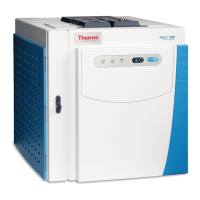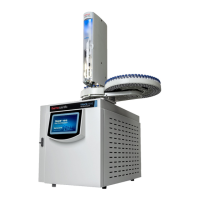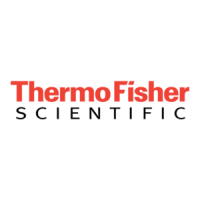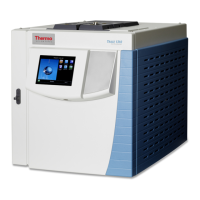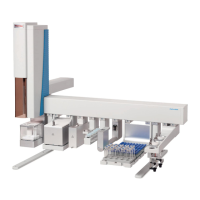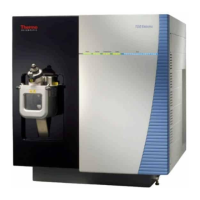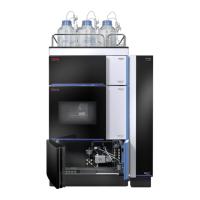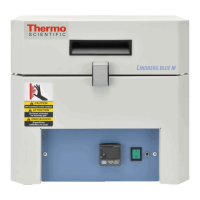Do you have a question about the Thermo Scientific TRACE GC Ultra and is the answer not in the manual?
Explains typographical conventions, symbols, and key names used throughout the manual.
Explains various symbols used on Thermo Fisher Scientific instruments.
Details hazards and precautions associated with using hydrogen.
Provides a recommended schedule for routine preventive maintenance tasks.
Details user-performed maintenance tasks for the Split/Splitless injector.
Explains the procedure and frequency for replacing the injector septum.
Provides guidance on cleaning or replacing the injector liner and associated symptoms.
Describes steps to take if a glass liner breaks inside the injector.
Details user-performed maintenance tasks for the Large Volume Splitless injector.
Explains the procedure and frequency for replacing the injector septum.
Provides guidance on cleaning or replacing the injector liner and associated symptoms.
Details user-performed maintenance tasks for the Cold On-Column injector.
Explains the procedure for replacing the O-ring in the Automated Operation Cold On-Column Injector.
Discusses symptoms and remedies for leaks in the rotary valve.
Details user-performed maintenance tasks for the Cold On-Column injector.
Explains the procedure for replacing the rotary valve seal.
Details user-performed maintenance tasks for the Cold On-Column injector.
Discusses symptoms and remedies for leaks in the rotary valve.
Explains the procedure for replacing the rotary valve seal.
Details user-performed maintenance tasks for the Packed Column injector.
Explains the procedure and frequency for replacing the injector septum.
Details the operating sequence for replacing the septum.
Details user-performed maintenance tasks for the Purged Packed Column injector.
Explains the procedure and frequency for replacing the injector septum.
Provides guidance on cleaning or replacing the injector liner and associated symptoms.
Details the operating sequence for replacing the septum.
Details user-performed maintenance tasks for the PTV injector.
Explains the procedure and frequency for replacing the septum.
Provides guidance on cleaning or replacing the injector liner and associated symptoms.
Describes steps to take if a glass liner breaks inside the injector.
Provides instructions for adjusting quartz wool packing in PTVLV liners.
Provides instructions for managing and controlling leaks in the chromatographic system.
Describes how to perform a leak check procedure.
Details the procedure for checking leaks on the injector side using a capillary column.
Covers leak checks for both injector and detector sides across various column types.
Details user-performed cleaning or replacement sequences for maintaining the FID.
Details the operating sequence for cleaning the FID jet.
Explains the procedure for replacing the FID jet.
Provides instructions for cleaning the FID collecting electrode.
Discusses factors affecting FID sensitivity and gas flow rates.
Describes the conditions and procedure for igniting the FID flame.
Details cleaning procedures for the ECD and handling precautions for the radioactive source.
Explains the requirement and procedure for performing a Wipe Test on the ECD.
Covers common issues, diagnoses, and remedies for ECD problems.
Provides instructions for cleaning the ECD collecting electrode.
Discusses temperature and gas effects on ECD sensitivity.
Describes effects of contamination on ECD performance and potential causes.
Provides a troubleshooting table for common ECD symptoms, diagnoses, and remedies.
Details maintenance procedures for the NPD, including thermionic source care.
Discusses the removal and replacement of the thermionic source.
Details the operating sequence for cleaning the NPD jet.
Explains the procedure for replacing the NPD thermionic source.
Discusses factors affecting NPD sensitivity, particularly the thermionic source.
Provides a troubleshooting table for common NPD symptoms, diagnoses, and remedies.
Details cleaning and replacement sequences for maintaining the FPD.
Details the operating sequence for cleaning the FPD jet.
Provides instructions for cleaning the FPD interferential filter.
Provides instructions for replacing the FPD heat shields.
Discusses factors affecting FPD sensitivity, including temperature and gas choices.
Provides a troubleshooting table for common FPD symptoms, diagnoses, and remedies.
Details maintenance procedures for the PID, focusing on UV lamp and window.
Explains the procedure for replacing the PID UV lamp.
Provides instructions for cleaning the PID UV lamp window.
Details the procedure for checking for leaks in a PID system.
Covers common issues, diagnoses, and remedies for PID problems related to sensitivity and contamination.
Discusses common causes of low sensitivity and contamination in PID detectors.
Addresses issues related to UV lamp function and failure messages.
Describes symptoms and remedies for detector cell contamination.
Details rules and precautions for maintaining TCD detector lifetime and performance.
Covers common issues, diagnoses, and remedies for TCD performance problems.
Discusses factors affecting TCD sensitivity, including temperature and gas flow.
Explains causes and indicators of baseline drift in TCD.
Describes causes of negative peaks in TCD and how to revert polarity.
Provides general guidelines for maintaining detectors in stack configuration.
Offers guidance on troubleshooting issues specific to detectors in stack configuration.
Details procedures for cleaning or replacing the collecting electrode when FID is on ECD.
Provides procedures for cleaning or replacing the collecting electrode when NPD is on ECD.
Details procedures for cleaning or replacing the collecting electrode when FPD is on ECD.
Explains the procedure for replacing the silver seal when FID is on ECD.
Details the procedure for replacing the silver seal when NPD is on ECD.
Provides instructions for replacing the silver seal when FPD is on ECD.
Provides instructions for regenerating carrier gas and split lines active carbon filters.
Provides guidance on diagnosing and resolving baseline-related issues.
Offers solutions for problems related to peak shape and appearance.
Addresses issues related to the reproducibility and sensitivity of analytical results.
Details causes and remedies for baseline drifting behavior.
Covers causes and remedies for rising baseline characteristics.
Discusses causes and remedies for high standing current in the baseline.
Addresses issues related to irregular baseline shapes like S-shaped or square waves.
Covers causes and remedies for high-frequency noise in the baseline.
Details causes and remedies for peak broadening in chromatograms.
Addresses causes and remedies for clipped peaks (at bottom or at top).
Covers causes and remedies for the appearance of double peaks.
Discusses causes and remedies for fronting peaks.
Addresses causes and remedies for ghost peaks, including contamination.
Covers causes and remedies for irregular peak shapes like chair-shaped.
Discusses causes and remedies for negative peaks.
Covers causes and remedies for the absence of peaks, including detector issues.
Addresses causes and remedies for peak tailing.
Discusses causes and remedies for unresolved or overlapping peaks.
Details causes and remedies for low reproducibility in peak area measurements.
Covers causes and remedies for poor sensitivity, especially with increased retention time.
Provides contact information and web addresses for Thermo Fisher Scientific support.
Provides chemical references and safety data for Acetone.
Lists chemical references and safety data for Methanol.
Provides chemical references and safety data for Toluene.
| Type | Gas Chromatograph |
|---|---|
| Oven Temperature Range | Ambient +4 °C to 450 °C |
| Temperature Programming Rates | 0.1 to 120 °C/min |
| Maximum Heating Rate | 120 °C/min |
| Column Type | Capillary |
| Oven Temperature Programming | Yes |
| Cool-down Time | From 450°C to 50°C in <4 minutes |
| Injector Options | Split/Splitless, On-Column, Programmable Temperature Vaporizing (PTV) |
| Injection Modes | Split, Splitless, On-Column |
| Injection Ports | Up to two injectors |
| Detector Options | FID, TCD, ECD, NPD |
| Detectors | Flame Ionization, Thermal Conductivity, Electron Capture, Nitrogen Phosphorus |
| Gas Flow Control | Electronic Flow Control (EFC) |
| Carrier Gas Control | Electronic Flow Control |
| Data Handling | Compatible with Chromeleon software |
| Weight | 50 kg |
